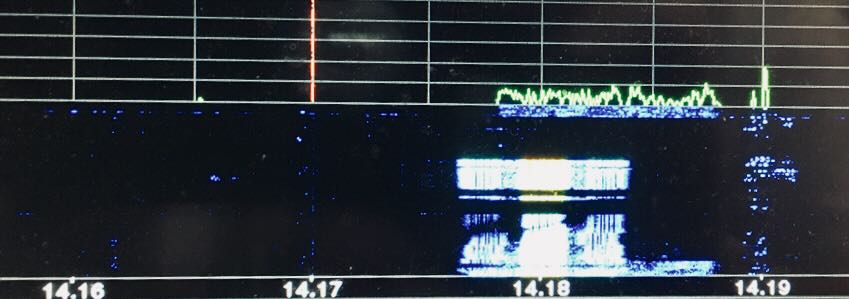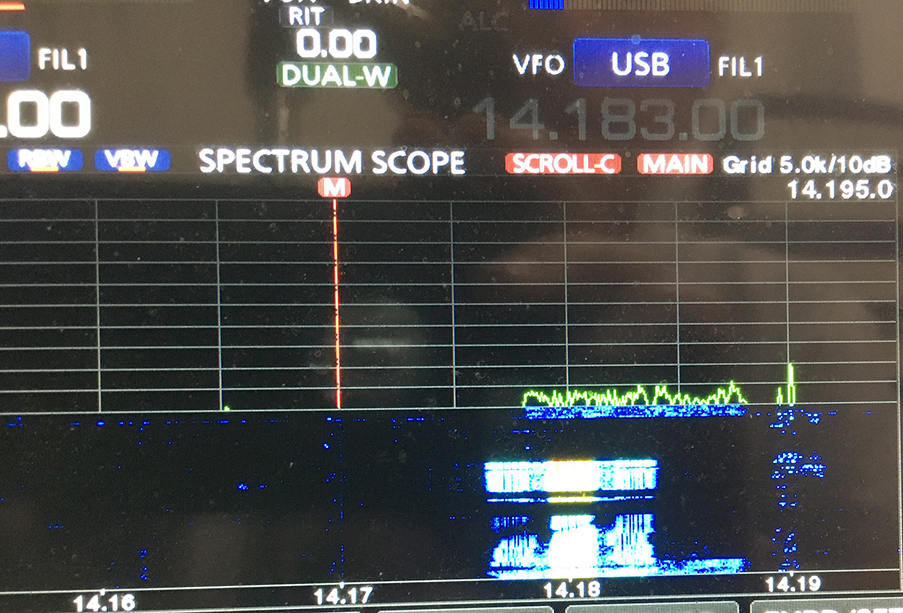 I received the following message from my buddy Rob (NC0B) who is trying to identify a couple of signals on the 20 meter band. Rob kindly gave me permission to post his email here on the SWLing Post with the idea that someone may be able to help him solve this:
I received the following message from my buddy Rob (NC0B) who is trying to identify a couple of signals on the 20 meter band. Rob kindly gave me permission to post his email here on the SWLing Post with the idea that someone may be able to help him solve this:
The following is a description of two odd digital signals observed on 20 meters with transmission modes I do not understand. They may not amateur transmissions, but I have no way to decode them. They stick out like a sore thumb on 20m in the Extra portion of the phone band. The time of day on August 20th was between 11:50 AM and 12:00 PM MDT.
Two weeks ago I was in QSO on 14,170 kHz and occasionally there was the same 10 kHz wide digital signal but centered on 14,171 kHz. It sounded like the old Russian jammers buzz saw modulation. Those signals from decades ago were much wider, and or course we didn’t have high resolution spectrum scopes back then. Today the same transmissions occurred several times, and more than once a minute for about 5 seconds each. In total the transmissions may have occurred on and off for about 10 minutes.
Then after a few 10 kHz transmissions a different signal came on the air a few times with what looked like a digital modulated carrier plus digital sidebands on each side of the middle signal.
Look at the attached JPG file and I’ll try to make sense out of it:
The waterfall image lasts about 50 seconds on the Icom IC-7610 set on slow. There are two different signals to differentiate in this image. The signal I observed two weeks ago and today is 10 kHz wide and today spans from 14,178 to 14,188. It shows up in green on the band scope, and just under it in blue on the water fall for about 3 seconds of the approximate 5 second transmission. You can also see at the bottom of the waterfall the previous transmission that has about 4 seconds worth saved on the waterfall running off the bottom. The horizontal span of the scope was set to 5 kHz per division.
Once the 10 kHz wide signal started, I went to Dual Watch so I could listen for KL7QOW on 14,170 kHz for a sked, and hear the buzzing signal on 14,183 kHz in SSB mode. That frequency placed the carrier position of the SSB 2.8 kHz bandwidth in the center of the 10 kHz wide signal.
Soon after I started observing the relatively flat spectrum of the 10 kHz signal, a new digital signal appeared about 3 kHz lower in frequency. At first it had a much stronger center modulated carrier about 2 kHz wide and then two symmetrical digital signals on each side within about a 6 kHz total bandwidth. I wasn’t able to capture the best picture of the 2nd signal as it appeared to be tuning up. The amplitude difference between the central signal and the separate sidebands initially was about 15 dB. Vertical divisions are 10 dB.
On the waterfall you can see the second type of signal is centered on about 14,180 kHz. The modulation depth of the outer pairs of signals were not constant, possibly due to selective facing. QSB was quite significant at this time at least to Alaska. You can see there was a short break of a few seconds in the 6 kHz wide signal. Every time I have seen the 10 kHz wide signal its amplitude across the transmission bandwidth has been fairly constant, always of short duration, and repeating several times within 10 minutes before terminating.
Does anyone have any idea what either of these transmissions are? I have heard of email digipeaters, but I would not think their bandwidth would be this wide.
Rob, NC0B
SWLing Post community: Please comment if you can help Rob ID these signals!


A Strange digital signal was noted between 14.242 and 14.252, about 10 khz wide. This was on feb 12th late evening cst. It looks like other digital signals, but much wider, 10 khz. The signal was strong. Its amplitude was higher than most signals seen but three time wider!! I don’t believe that amateur radio stations can produce the kind of power that appeared on my screen. Certainly this is not an amateur signal at that bandwidth and frequency. MOST IMPORTANT!! This same 10 khz wide signal has also been noted in the 40 meter band. I have only seen this on 20 and 40 and always 10 khz wide. I sure would like to know what this is especially if it is illegal. Best Regards, KF0EAO
Russian Kontayner radar sounder is about 10kHz wide, occasionally hops into amateur bands and does sounds like Woodpecker.
How can we do this without audio / moving video of the spectrum ?
I will stick my neck out here & say it is Vara. Ockams razor says it is probably VarAC https://www.varac-hamradio.com/
If you download the Vara Client from here https://rosmodem.wordpress.com/ you can put it in “monitor” mode & see if that decodes it..
The transmission is independent sideband because the sidebands are not identical as they are in AM. There is also a gap where the carrier should be.
Thus independent sideband suppressed carrier
According to Wikipedia “Suppressed-carrier ISB was employed in point-to-point (usually overseas) radiotelephony and radioteletype by shortwave (HF). In military use, ISB usually referred to a close pair of FSK radioteletype channels which could be demodulated by a single receiver, and employed in fleet broadcast, point-to-point, and between larger vessels and shore stations on HF and UHF.”.
Looks like a form of spread spectrum with the spread amplitude being so even
I wonder if the signal you received may be a PACTOR II transmission
https://www.sigidwiki.com/wiki/PACTOR_II